- Target audience: parents;
- Serious mental illness;
- Unhealthy eating habits;
- Takes different forms;
- Interferes with daily life;
- Common disorders include:
- Anorexia Nervosa;
- Bulimia Nervosa;
- Binge eating disorder.
An eating disorder is a mental illness that is primarily characterized by unhealthy eating habits. An individual either eats too much or too little. Individuals become preoccupied with their body weight or the shape of their bodies. In that regard, they either deny themselves food or consume food in excess. Eating disorders take many different forms and affect the daily lives of victims negatively. According to the Diagnostic and Statistical Manual of mental Disorders (DSM), three of the most common eating disorders include anorexia nervosa, anorexia bulimia, and binge eating disorder. This presentation will discuss nervosa bulimia and present its causes, risk factors, and treatment options.
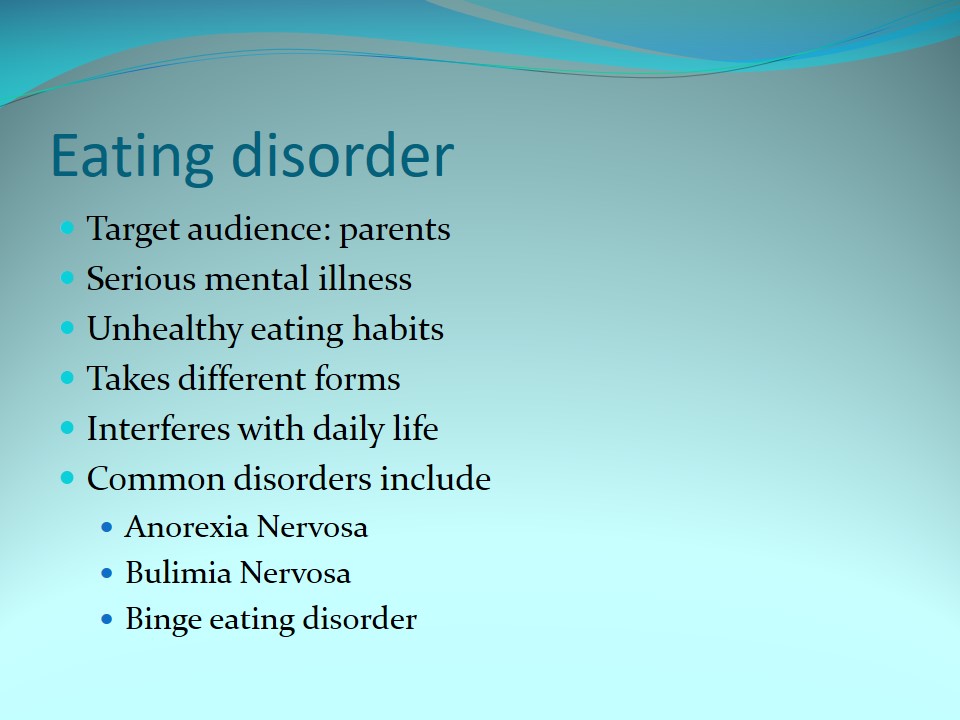
Bulimia nervosa
- A serious mental illness;
- Binge eating;
- Loss of control;
- Feelings of guilt and shame;
- Compensatory behaviors: fasting and vomiting;
- Starts with weight loss dieting;
- Obsession with one’s body weight.
Bulimia nervosa is a serious mental illness that is characterized by recurrent episodes of consuming large amounts of food over short periods of time. This disorder is caused by a lack of self-control, and victims usually suffer guilt and shame after a binge-eating episode (Reel, 2013). After such episodes, individuals exhibit compensatory behaviors such as fasting, over exercising, and vomiting. The disorder starts with an individual’s embracement of weight-loss dieting (Reel, 2013). The starvation that results from dieting triggers a strong urge to eat, which pushes individuals to consume more food. In many cases, people with this disorder eating unhealthy food (sugary and fatty) because it is sweet. If the individual gives in to the urge, they are unable to control their desire and end up overeating. Over time, the cycle repeats itself: dieting, strong urges to eat, binge-eating, and compensatory behaviors.
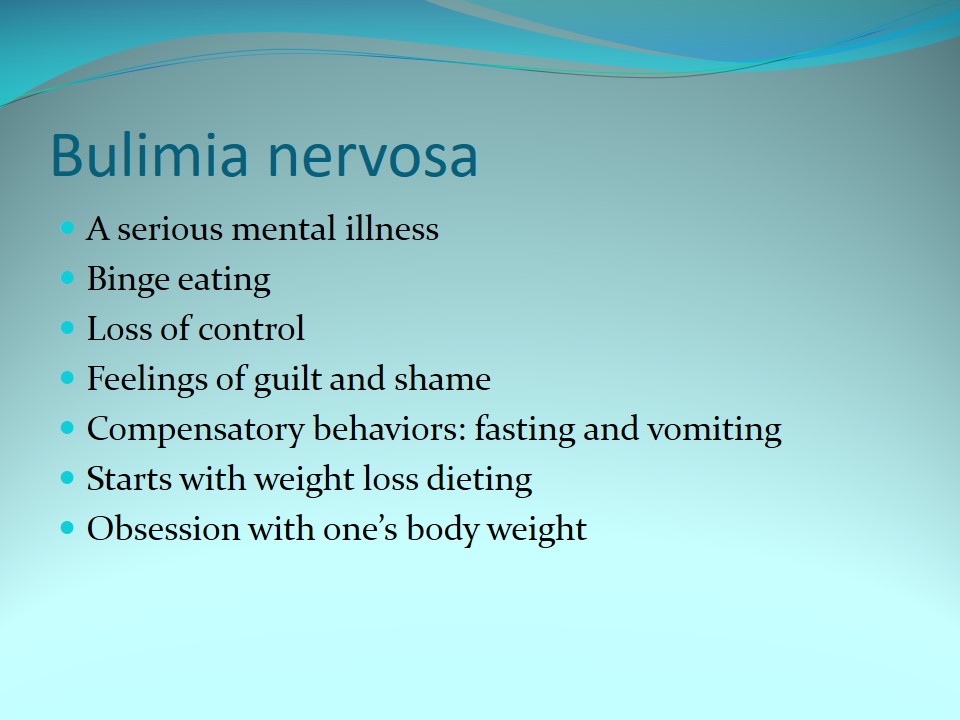
Risk factors
- Gender.
- Genetics.
- Dysfunctional family dynamics.
- Traumatic life experiences.
- Social pressure.
- Psychological factors.
- Biological factors:
- Hormones;
- Heredity;
- Cultural influence:
- Ideal body size and shape;
- Media influence;
- Advertising: magazines and the Internet;
- Frequent dieting.
Gender is one of the most common risk factors. For example, the Department of Health and Human Services has revealed that approximately 90% of anorexics are females. Women are more concerned with their body weight and shape than men (Reel, 2013). Therefore, they are more likely to experience binge-eating episodes after periods of starvation. Dysfunctional family dynamics also contribute to bulimia nervosa. Children whose parents are bulimic or who have been criticized because of their bodies are at a high risk of developing the disorder. Psychological risk factors include self-loathing, low self esteem, and hopelessness (Reel, 2013). When an individual has low self-esteem, they will not thin about their weight or physical fitness because of they feel worthless.
Researchers have suggested that biological factors such as hormones and hereditary factors might predispose individuals to bulimia nervosa. Moreover, the imbalance of chemicals in the brains might increase the likelihood of developing the disorder. In many Western countries, the ideal female body is exceptionally thin (Agras & Robinson, 2018). Advertisements in magazines and the Internet portray thin as the definition of beauty. In that regard, many women try approaches such as dieting to attain the ideal body shape and size. This search for the ideal body exposes them to the risk of bulimia nervosa. People who diet frequently are more likely to develop bulimia nervosa that people who do not (Agras & Robinson, 2018).
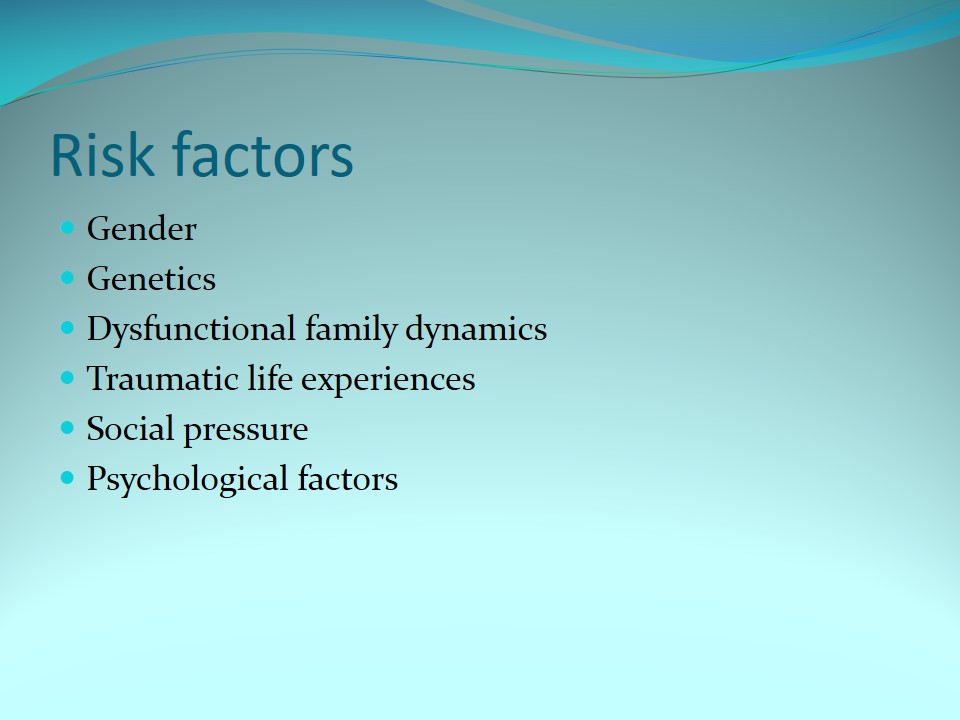
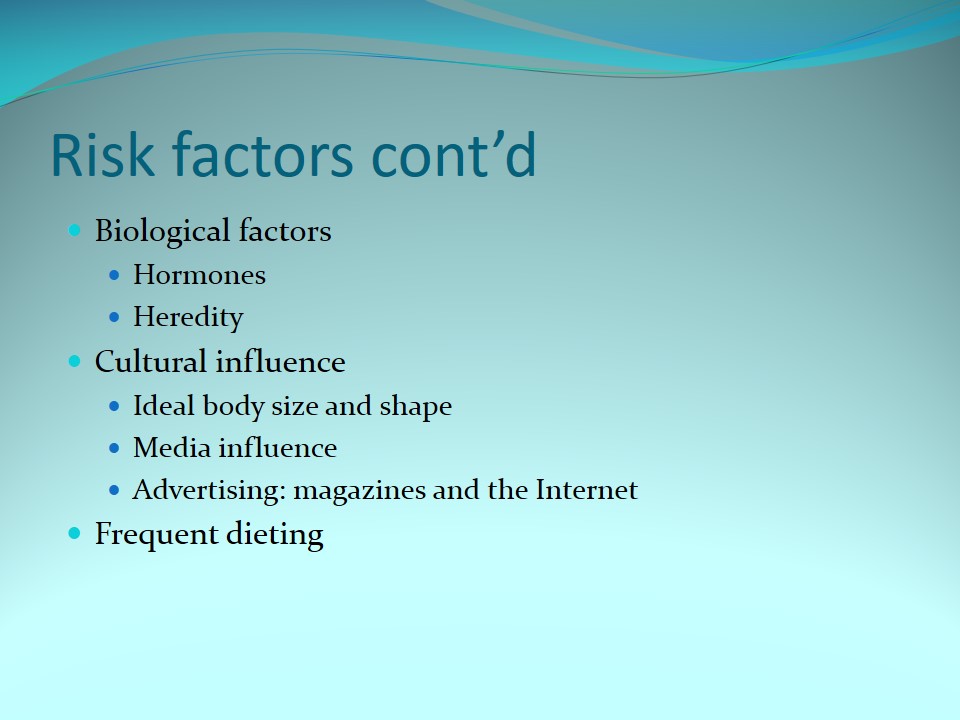
Signs
- Repeated binge eating.
- Fluctuations in weight.
- Food-related deceptive behavior.
- Depression.
- Sensitivity to body weight or appearance.
- Fixation on calorie intake.
A common sign of bulimia anorexia is binge eating. Individuals eat large amounts of food within short periods repeatedly (Reel, 2013). In many cases, this behavior is associated with fluctuations in weight that might prompt them to take up dieting. Individuals also exhibit an abnormal obsession with their weight or shape, which could affect their self esteem (Abrahams, 2015). Other vital signs include low blood pressure, depression and anxiety disorders, a lack of energy, and a fixation on calorie intake.
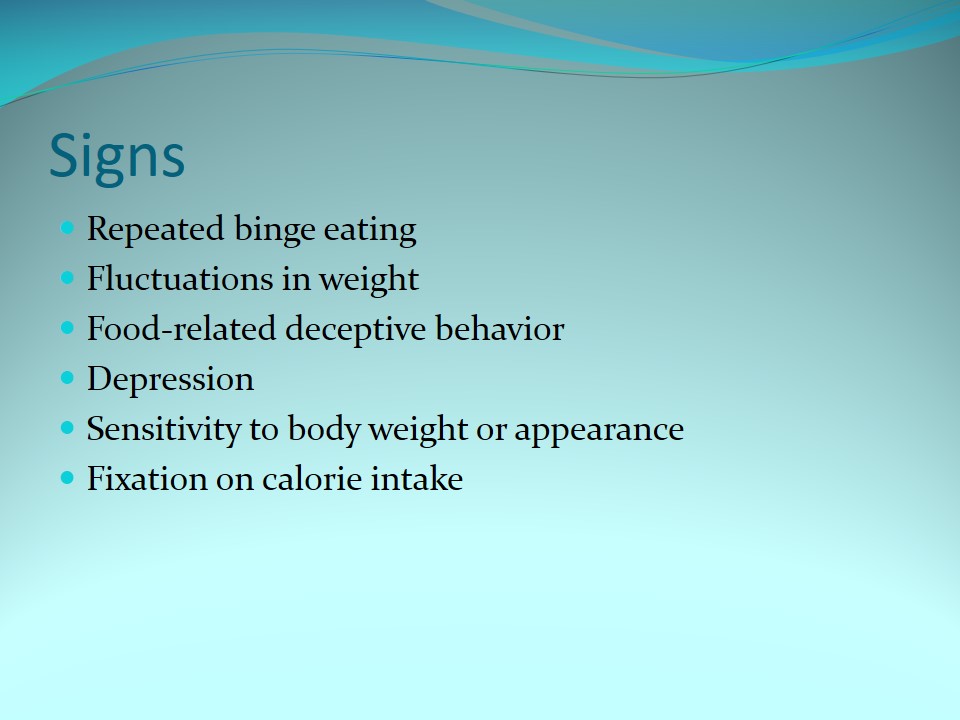
Prevalence
- 1% of Americans.
- Females: 90-95 %.
- 25% of children are boys.
- 76%: purging subtype.
- 24%: non-purging subtype.
- Common among females than males.
- Females between 15-24.
Government statistics reveal that approximately 100,000 people are diagnosed with bulimia nervosa every year. The disorder is common among young females aged 15-24 (Eating disorders, 2017). women are at a higher risk of developing the disorder than males because of their obsession with body weight and shape. Moreover, dieting is more common among females than males.
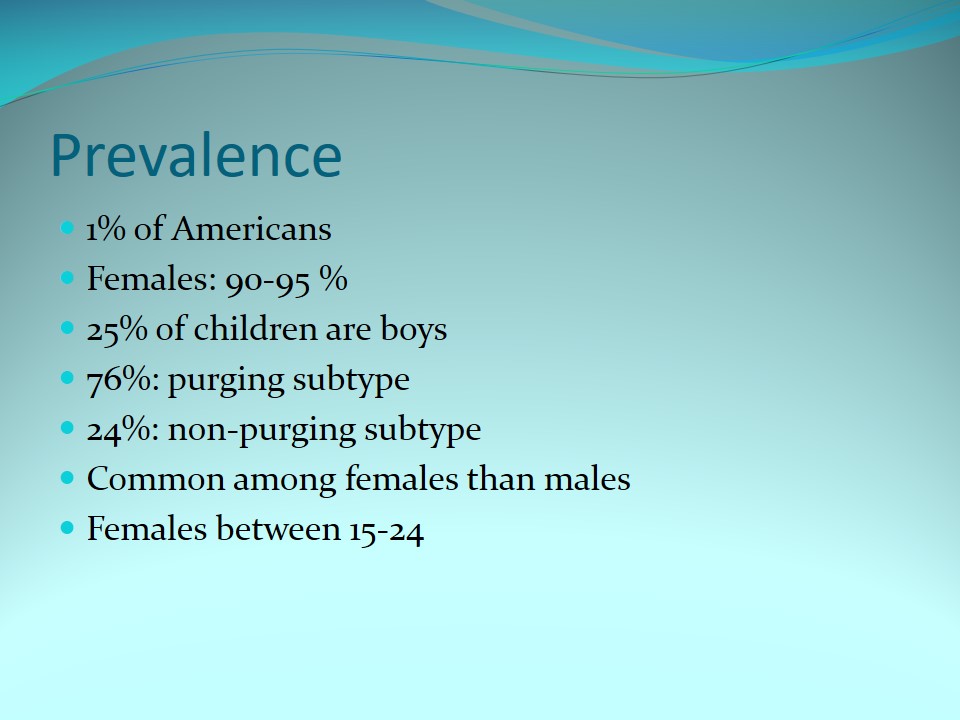
Incidence
- Limited statistical information available.
- 1-5% of general population.
- 300/100000: 16-20byears.
- 150/100000: 10-24 years.
- Recovery rate is 55%.
- Psychosomatic symptoms experienced after recovery.
- Body image problems persistent.
Bulimia nervosa occurs among 1-5% of the general population (Eating disorders, 2017). A 2009 national population-based study indicated that the incidence of bulimia nervosa was different for the two subtypes. For the purging subtype, the incidence rate was 300 for every 100,000 people per year while for the non-purging type, it was 150 for every 100,000 people (Abrahams, 2015). The disorder is more common among children aged 10-24 years (Eating disorders, 2017). the recovery rat was 55% and women reported body image problems and psychosomatic symptoms even after receiving treatment.
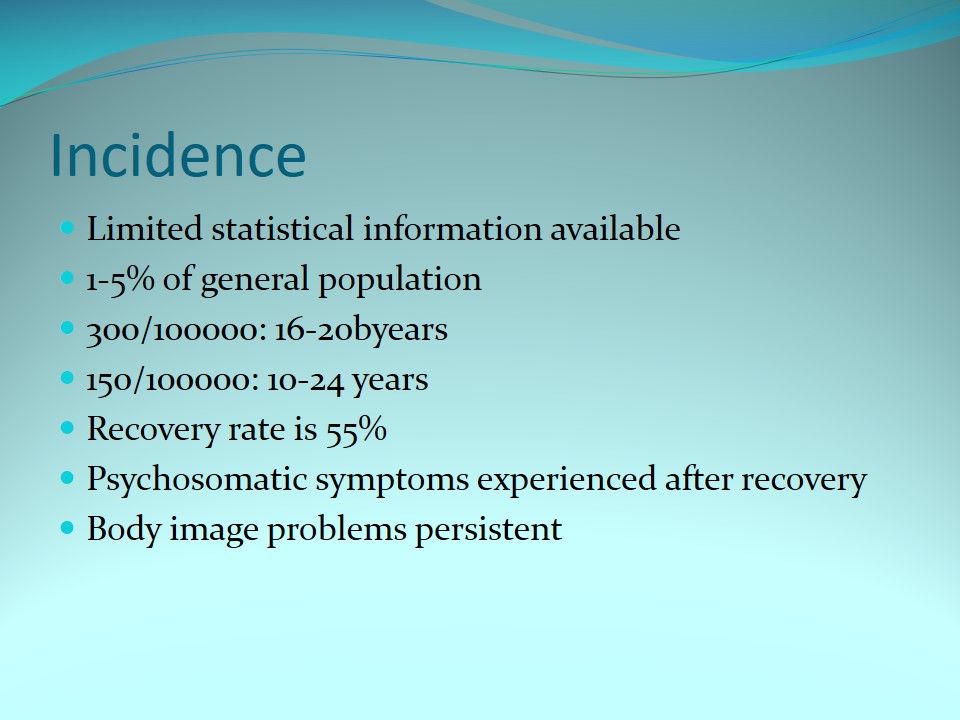
Treatment options
- Psychotherapy:
- Cognitive behavioral therapy;
- Family-based therapy;
- Interpersonal psychotherapy.
- Medication.
- Alternative medicine.
- Nutrition education.
Psychotherapy involves the discussion of an individual’s food-related challenges with a mental health provider. The three most effective types of psychotherapy include cognitive behavioral therapy, family-based therapy, and interpersonal psychotherapy (Abrahams, 2015). These interventions help patients identify and change their beliefs and attitudes regarding their behaviors. For example, cognitive behavioral therapy teaches individuals how to change their behaviors attitudes toward food. It is one of the most effective therapeutic approach toward the treatment of bulimia nervosa. Antidepressants are common medication sued to treat bulimia (Agras & Robinson, 2018). They reduce the symptoms of the disorder, and work effective when used together with psychotherapy. Prozac is the only drug approved by the Food and Drug Administration to treat bulimia (Agras & Robinson, 2018). Nutrition education is also very important. Dietitians and health care providers provide information on healthy eating and develop healthy eating plans for patients (Abrahams, 2015). Research ahs shown that developing and adopting health eating plans can be used effectively in the treatment of bulimia nervosa. The main goal of this intervention is to educate individuals on the effects of eating unhealthy foods on their wellbeing.
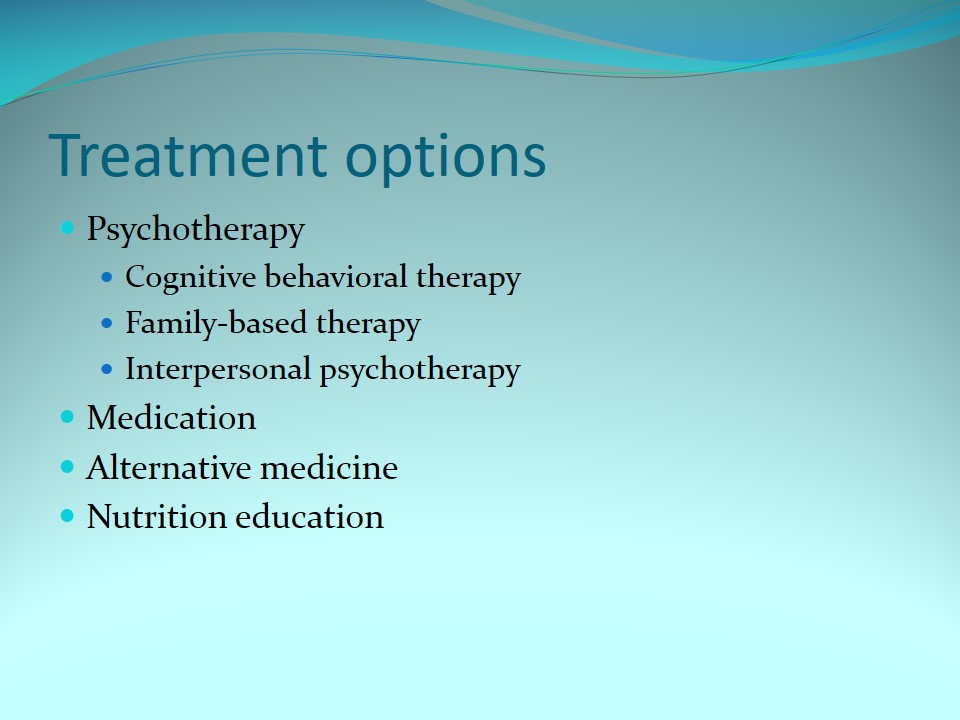
Resources
- American Psychiatric Association;
- Binge Eating Disorder Association (BEDA);
- Academy for Eating Disorders (AED);
- Eating Disorder Hope;
- Eating Disorder Coalition (EDC);
- Multi-Service Eating Disorder Association (MEDA);
- National Eating Disorder Association (NEDA);
- Substance Abuse and Mental Health Services Administration (SAMHSA).
Parents can access resources on bulimia nervosa from different sources. These include the American Psychiatric Association, Binge Eating Disorder Association (BEDA), Academy for Eating Disorders, Eating Disorder Hope, and the Eating Disorder Coalition. Others include the Multi-Service Eating Disorder Association (MEDA), the National Eating Disorder Association (NEDA), and the Substance Abuse and Mental Health Services Administration (SAMHSA). Each of these organizations provides detailed information on their websites regarding he various eating disorders. For instance, they discuss the causes, risk factors, symptoms, and the treatment of bulimia nervosa. Some of them provide book recommendations on various eating disorders. The guide readers on how they can identify someone with an eating disorder. Many of them provide their telephone numbers in case someone wants to contact them for help or to seek additional information. In addition to these organizations, parents can use the internet to find information on bulimia nervosa.
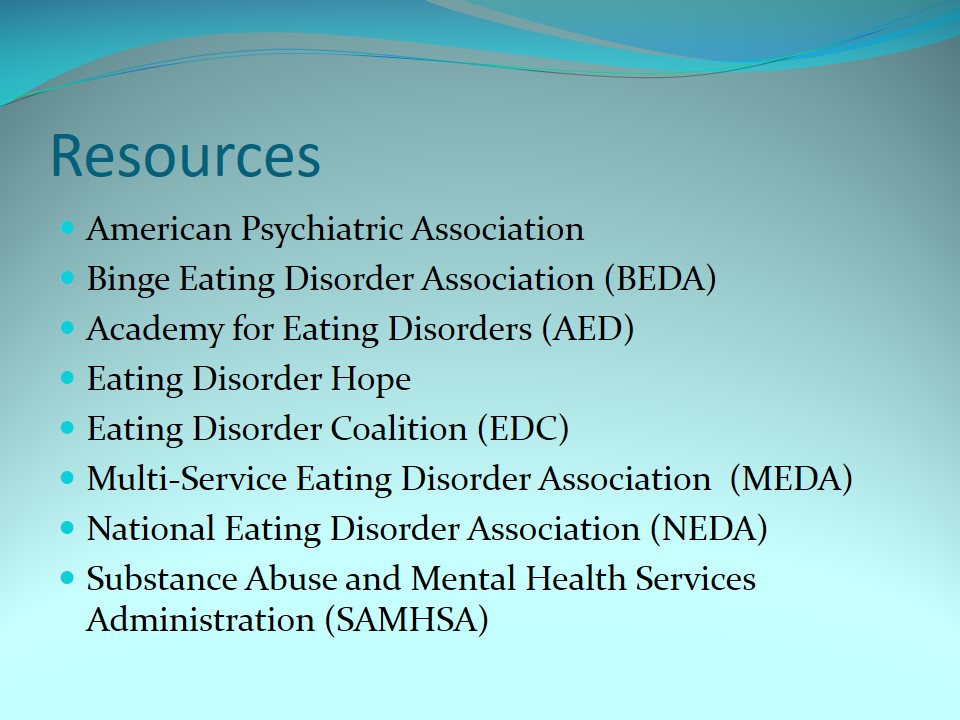
Conclusion
- Bulimia is a mental illness;
- Signs include:
- Binge eating;
- Obsession with body weight and shape;
- Depression;
- Prevalent among females than males;
- Risk factors:
- Gender , social forces;
- Treatment options:
- Psychotherapy;
- Nutrition education;
- Medication.
Bulimia is a life threatening illness that occurs among 1-5 percent of the general population. Commons signs include binge eating, depression, and obsessions with weight and size. Risk factors include gender, biology, and dysfunctional family dynamics. The main treatment options include psychotherapy, nutrition education, and medication. According to studies, the best mode of treatment combines nutrition education and therapy. Medication is usually applied in cases where other interventions fail or produce unsatisfactory results. It is important for parents to monitor the eating habits of their children because the development of an eating disorder affects their wellbeing.
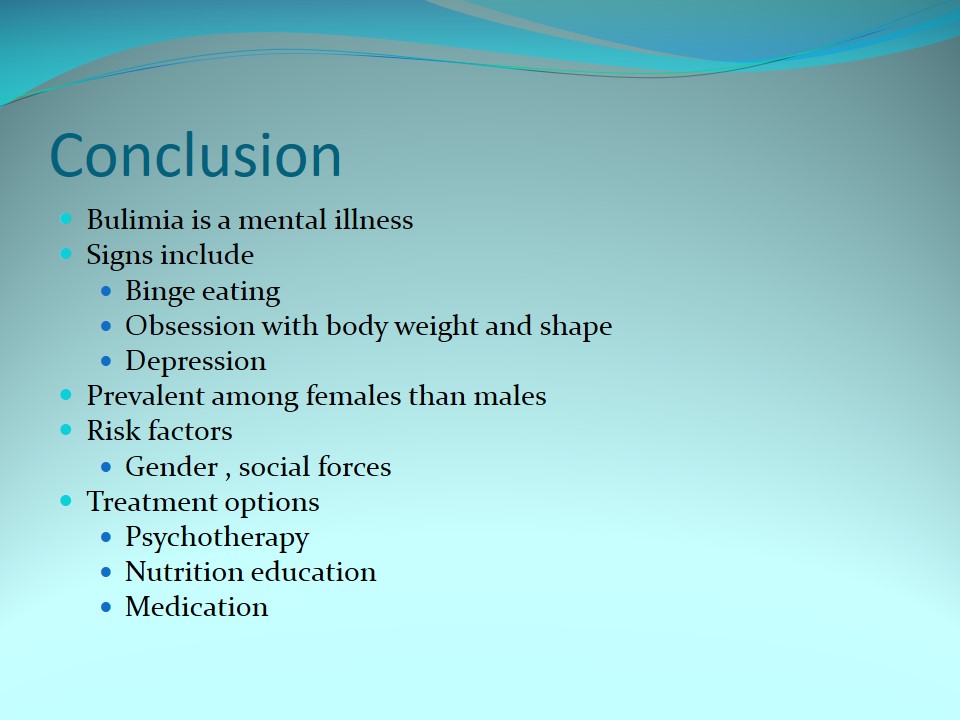
References
Abrahams, S. (2015). Eating disorders: The facts. New York, NY: Oxford University Press.
Agras, W. S., & Robinson, A. (2018). The Oxford handbook of eating disorders. New York, NY: Oxford University Press.
Eating disorders. (2017). SAMHSA. Web.
Reel, J. J. (2013). Eating disorders: An encyclopedia of causes, treatment, and prevention. New York, NY: ABC-CLIO.